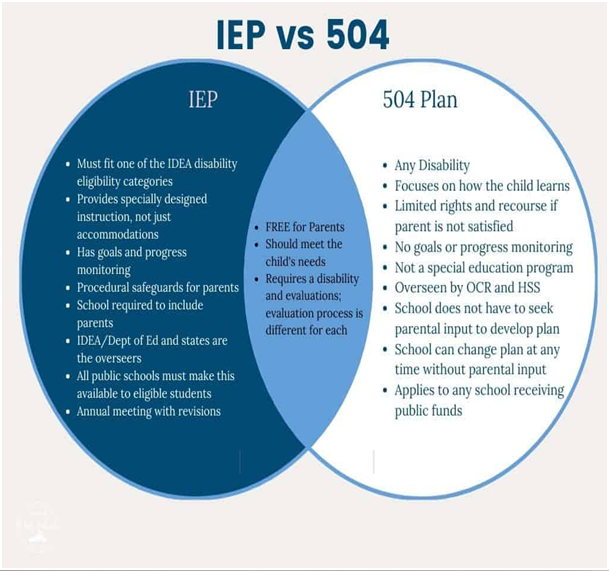Navigating the special education environment may be difficult. You’ve probably heard of 504 plans and Individualized Education Programs (IEPs), but it’s not always clear how they differ. Educators who have pursued offline or online special education courses know that a 504 plan and an IEP are two legal structures designed to support children with disabilities.
They serve various purposes despite their many similarities. Continue reading to examine the variations: IEPs versus 504 plans. You will learn about each one’s intentions, values, and potential benefits for your child. You will be able to make informed decisions about your child’s education with this knowledge.
What Is An IEP?
The Individuals with Disabilities Education Act (IDEA) governs an IEP. This federal law guarantees special education and associated services to qualified children with disabilities. When a student has an IEP, they can get specially planned teaching that is based on their goals, objectives, and impairments.
An IEP is a working document that may be modified as needed. To support the student’s advancement in areas impacted by their disability, a special education teacher who has pursued offline or online learning disabilities courses for teachersworking in the student’s Least Restrictive Environment (LRE) focuses on these objectives.
Every special education child’s needs are outlined in an IEP plan, along with the following ones that are required:
- A classroom that supports the student’s educational placement
- As needed, provide accommodations and changes
- Additional services include transportation, counseling, speech therapy, occupational therapy, and an extended school year
What Is There In An IEP?
Both the child’s personal information and the customized education plan created to suit their requirements must be included in an IEP. The IEP report in special education provides information on the child’s current functional performance (PLAAFP), which explains how the child’s handicap affects their engagement with the general education curriculum, as well as their current academic success levels.
According to IDEA, the following elements of an IEP are required:
- Annual objectives that are quantifiable
- Recurring updates on kids’ development
- Additional assistance, associated services, and special education
- Reduced levels of restriction in the surroundings
- Participation of students in district and state exams
- An explanation of the services provided
- Transitional elements after secondary education
- Activities and services for transitioning
What Is A 504 Plan?
A federal civil rights legislation known as Section 504 of the Rehabilitation Act guarantees that no person would face discrimination because of their disability. A 504 plan covers this provision. These plans offer assistance and changes, but they lack clear goals or objectives. 504 plans are evaluated on a need basis regularly. Parents are welcome to ask for more frequent meetings to discuss the plan if they believe it is necessary.
What Is Included In A 504 Plan?
A federal civil rights legislation known as Section 504 of the Rehabilitation Act guarantees that no person would face discrimination because of their disability. A 504 plan covers this provision. These plans offer assistance and changes, but they lack clear goals or objectives. 504 plans are evaluated on a need basis regularly. Parents are welcome to ask for more frequent meetings to discuss the plan if they believe it is necessary.
Who Qualifies For IEP?
IDEA states that pupils who fall into one of the following 13 categories may be eligible for free and adequate education (FAPE) in special education:
- Deaf-blindness
- Autism
- Deafness
- Emotional disturbance
- Traumatic brain injury
- Intellectual disability
- Visual impairment
- Multiple disabilities
- Language and speech impairment
- Hearing impairment
- Specific learning disability
- Orthopaedic impairment
- Other Health impairments
IEPs are only valid for students in grades K–12; when a student graduates from high school, they become invalid. An IEP is a legally enforceable document that offers a thorough plan for customized teaching and support in the areas where a student’s handicap interferes with their ability to learn.
What Are The Services Included In IEP And 504 Plans?
Here is what you can expect to be included in an IEP and 504 Plan:
-
IEP Includes Specialized Instruction, Accommodations, And Related Services
Working with a learning professional, such as a math or reading coach, is what is meant by specialized instruction. A student may be ‘pulled out’ of the classroom to work with the expert in a private space, or this can be done in the classroom.
‘Related services’ refer to therapies that support a student’s acquisition of abilities necessary for learning. Physical therapy, occupational therapy, speech therapy, and behavioral treatment are a few examples. A 504 does not include explicit goals and objectives for the student’s growth; in contrast, an IEP does.
-
504 Includes Only Accommodation
These modifications are made to the school setting to assist a kid in overcoming obstacles brought on by their impairment. These include devices such as voice-to-text software, Braille or online books with audio output, or communication devices.
Additional accommodations for children with ADHD include things like front-row desks, regular breaks, and noise-canceling headphones.
What Are The Key Differences Between IEP And 504 Plan?

Source: adayinourshoes.com
The following lists some of the most significant variations between these two plans:
- An IEP provides a more detailed description of services and supports that define established yearly objectives, even if the major focus of a 504 Plan is frequently on reasonable accommodations.
- A 504 Plan is frequently produced by municipal legislation, but an IEP involves an official review procedure and an IEP team meeting. The methods for getting documents differ.
- Both mandate that educational institutions give students with disabilities free and suitable public education; all students, regardless of disability, are entitled to educational advantages.
What Is The Best Fit For Your Students?
While both approaches can help with adjustments and are appropriate for children in grades K–12, there are some significant distinctions between them. Both strategies can help youngsters grow into more self-sufficient adults. With the help of the Special Education Courses in UAE, educators will find it easier to comprehend the two plans and select the one that best meets the needs of their students.



